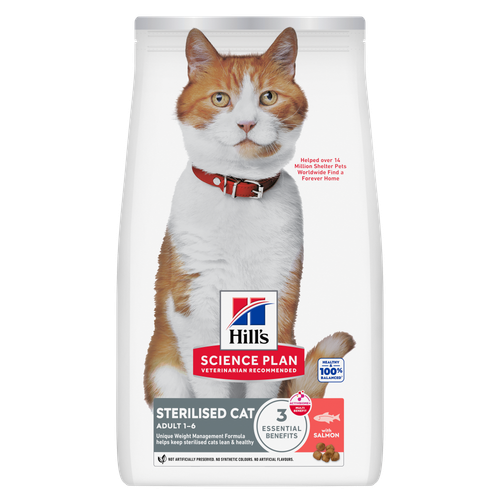
-
Find the right food for your petTake this quiz to see which food may be the best for your furry friend.Find the right food for your petTake this quiz to see which food may be the best for your furry friend.Featured products
 Adult Light Dog Food
Adult Light Dog FoodHill's Science Plan Light Adult Wet Dog Food is a complete premium pet food for adult dogs that tend to gain weight easily. This deliciously smooth loaf is formulated to deliver the appropriate amount of energy to support weight maintenance in adult dogs.
Shop Now Large Breed Adult Dog Food
Large Breed Adult Dog FoodHill's Science Plan Large Breed Adult Dog Food with Lamb & Rice is a complete pet food, specially formulated with ActivBiome+ Multi-Benefit Technology.
This food is specifically designed to fuel the energy needs of large breed dogs during the prime of their life.Shop Now Perfect Digestion Large Breed Puppy Food
Perfect Digestion Large Breed Puppy FoodPrecisely balanced nutrition with Hill's ActivBiome+ prebiotic blend actively contributes to supporting digestive health and overall wellbeing to help your pet feel their best
Shop NowFeatured products Adult Cat Food
Adult Cat FoodHill's Science Plan Adult Cat Food with Chicken is a complete pet food, specially formulated with ActivBiome+ Multi-Benefit Technology.
This food is specially formulated to fuel the energy needs of cats during the prime of their life.Shop Now Sterilised Adult Cat Food
Sterilised Adult Cat FoodHill's Science Plan Adult Sterilised Cat Dry Food with Salmon is specially formulated with ActivBiome+ Multi-Benefit Technology. It is a precisely balanced nutrition, tailored to meet the needs of sterilised cats, to help keep sthem lean & healthy.
Shop Now CULINARY CREATIONS ADULT CAT FOOD
CULINARY CREATIONS ADULT CAT FOODHill's Science Plan CULINARY CREATIONS Adult cat food with Salmon & Carrots was formulated to provide a great-tasting experience to cats. Its delicious flavour and texture are combine with essential nutrients to support cats' optimal health during the prime time of their life. Specially formulated with high-quality salmon protein, essential taurine for heart health & balanced minerals to support kidneys & bladder.
Shop Now -
Dog
- Dog Tips & Articles
-
Health Category
- Weight
- Food & Environmental Sensitivities
- Urinary
- Digestive
- Joint
- Kidney
-
Life Stage
- Puppy Nutrition
- Adult Nutrition
- Senior Nutrition
Cat- Cat Tips & Articles
-
Health Category
- Weight
- Skin & Food Sensitivities
- Urinary
- Digestive
- Kidney
-
Life Stage
- Kitten Nutrition
- Adult Nutrition
Featured articles The Incredible Science Behind Your Pet's Microbiome
The Incredible Science Behind Your Pet's MicrobiomeLearn what your pet's microbiome is, how it contributes to your pet's gut and overall health, and why nutrition is important in maintaining healthy microbiomes.
Read More Pet Nutrition: What Makes "Healthy" Pet Food Healthy? | Hill's Pet
Pet Nutrition: What Makes "Healthy" Pet Food Healthy? | Hill's PetIn people, the right diet is very important. If you are eating the wrong way for your metabolism, activity level, age and lifestyle you could end up with health issues.
Read More Microchipping: The Facts | Hill's Pet
Microchipping: The Facts | Hill's PetThe government has announced that as of April 2016, all dogs in the UK must be microchipped by law.
Read More -


Common Cat Pain Symptoms

A cat experiencing pain will often display behavioural changes that can serve to tip off an astute pet parent to the fact that something's wrong. According to Vetstreet, common signs your cat is sick or in pain include:
- Hiding
- Sitting still and hunched up
- Loss of interest in people, other pets, or activities
- Neglecting to groom themselves, or over-grooming in one spot
- Purring, excessive meowing, or unusual vocalizations
- Restlessness or aggression toward friendly surroundings
- Doing her business outside the litter box
Kitties in pain might also show a loss of appetite, unusual vomiting, clingy behaviour, or other noticeable changes in personality and demeanour. A cat experiencing chronic pain, such as arthritis, might stop using the litter box altogether because it's too difficult to climb into. For this reason, she may also stop climbing or jumping onto the high perches of her cat tree.


Tasty Tips
How your Vet Can Help

Any abnormal behaviour from your cat should prompt a visit to her veterinarian, who can help determine whether these changes are due to pain or illness and then work with you to treat the underlying cause. The vet can also help with pain management–this might include prescription pain medication, heat therapy, physical rehabilitation, or even massage.
If your kitty is overweight, your vet might also place her on a weight-management food, especially if she's experiencing chronic joint pain. Certain joint supplements can help maintain her mobility too, but you may ultimately want to explore a therapeutic food to help manage an underlying condition.
One thing you should never do for your kitty is to administer over-the-counter pain medications, which could be very toxic to feline digestive systems. You should also check with your vet regarding any supplements you plan to give her to make sure they're safe. The vet might also prescribe mood-stabilizing drugs to help your sick cat cope with both the pain and accompanying changes in her lifestyle.
How You Can Help
Back at home, consider relocating her bed, food dishes, water bowls, and litter box so they're easier for her to get to. Make sure the litter box is simple enough to climb in and out of as well. If you have a model with a lid or deep sides, for instance, you might need to replace it with an open, shallower structure, and keep it scooped clean more frequently to accommodate for her disadvantage. Big family? Prevent other pets or children from trying to play or roughhouse with her. She may escape it herself, but you don't want her to lose trust in people while she's recovering.
Of course, the best medicine is preventive. Annual vet checkups and a well-balanced food will go a long way toward preventing your cat from developing a painful condition.
As a pet parent, you no doubt want your kitty to be healthy for her entire life. Learning to recognise when she's in pain will go a long way to improving your furry companion's quality of life.
Contributor Bio

Jean Marie Bauhaus
Jean Marie Bauhaus is fiction author and freelance writer and editor living in Tulsa, Oklahoma. She writes frequently about pets and pet health in her home office, where she is assisted by a lapful of furbabies.


Jean Marie Bauhaus is a pet parent, pet blogger, and novelist from Tulsa, Oklahoma, where she usually writes under the supervision of a lapful of fur babies.
Related products

Hill's Science Plan CULINARY CREATIONS Adult cat food with Salmon & Carrots was formulated to provide a great-tasting experience to cats. Its delicious flavour and texture are combine with essential nutrients to support cats' optimal health during the prime time of their life. Specially formulated with high-quality salmon protein, essential taurine for heart health & balanced minerals to support kidneys & bladder.

Hill's Science Plan Mature Adult Cat Food with Chicken is a complete pet food, specially formulated with ActivBiome+ Multi-Benefit Technology.
This food supports graceful aging in cats, providing a synergistic ingredient blend to help support energy & activity levels.

Hill's Science Plan Adult Cat Food with Chicken is a complete pet food, specially formulated with ActivBiome+ Multi-Benefit Technology.
This food is specially formulated to fuel the energy needs of cats during the prime of their life.

Hill's Science Plan Adult Sterilised Cat Dry Food with Salmon is specially formulated with ActivBiome+ Multi-Benefit Technology. It is a precisely balanced nutrition, tailored to meet the needs of sterilised cats, to help keep sthem lean & healthy.
Related articles

Learn how your cat's poo can be a good indicator of her overall health, including how to spot unhealthy or abnormal cat poop and what it might mean.

Cats with sensitive skin have special needs and even healthy cats can sometimes develop poor skin health. Learn more about sensitive skin symptoms in your cat, what you can do to help your pet feel more comfortable and get recommendations on sensitive skin cat food.

Understand common skin issues in cats and how to manage them effectively. Learn signs and prevention, and get care tips. Find out more at Hill's Pet.

Learn about the causes of cat dermatitis, how to spot the symptoms and the best treatment options. Visit Hill's Pet for detailed guidance and tips.

Put your cat on a diet without them knowing
Our low calorie formula helps you control your cat's weight. It's packed with high-quality protein for building lean muscles, and made with purposeful ingredients for a flavourful, nutritious meal. Clinically proven antioxidants, Vitamin C+E, help promote a healthy immune system.
Put your cat on a diet without them knowing
Our low calorie formula helps you control your cat's weight. It's packed with high-quality protein for building lean muscles, and made with purposeful ingredients for a flavourful, nutritious meal. Clinically proven antioxidants, Vitamin C+E, help promote a healthy immune system.

